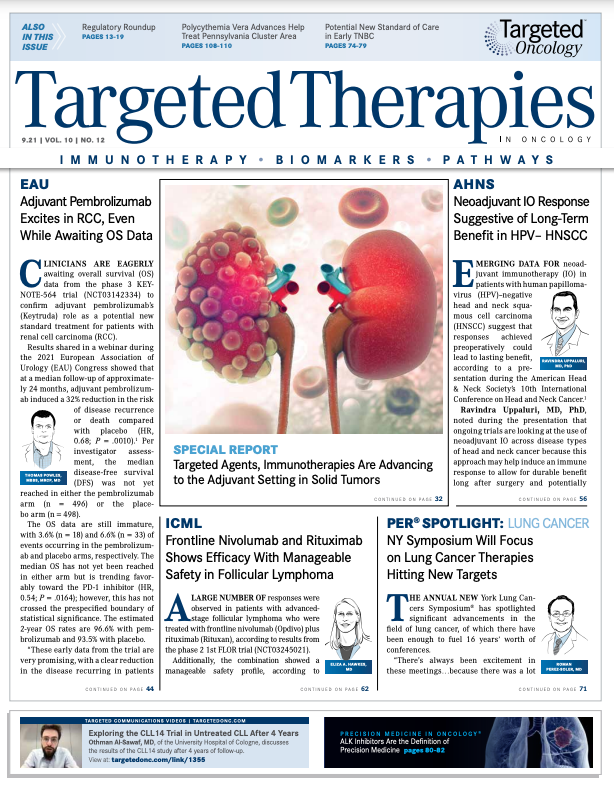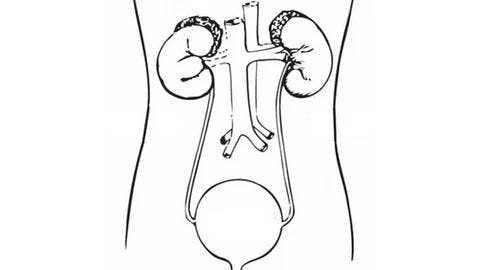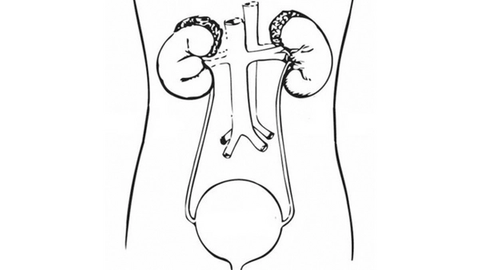Early-Phase Targeted Agents Are Poised to Expand Armamentarium in HNSCC
The emergence of early-phase immune-oncology agents and their respective novel mechanisms of action in head and neck squamous cell carcinoma suggests a new standard of care in the metastatic first-line setting within the next 2 years.
Ezra Cohen, MD

The emergence of early-phase immune-oncology agents and their respective novel mechanisms of action in head and neck squamous cell carcinoma (HNSCC) suggests a new standard of care in the metastatic first-line setting within the next 2 years, according to a presentation made during the American Head & Neck Society 10th International Conference on Head andNeck Cancer.1 Ezra Cohen, MD, presented data on 4 agents: lenvatinib (Lenvima), bintrafusp alfa, eftilagimod alpha, and ALX148.
“Most of these agents may [eventually be used] in locally advanced disease, but the challenges are how to combine them, how to sequence them, and how to use them,” Cohen said. Cohen is chief of the Division of Hematology-Oncology and associate director of translational science at Moores Cancer Center at UC San Diego Health in California.
The combination of lenvatinib and pembrolizumab (Keytruda) demonstrated a manageable safety profile and promising antitumor activity in a phase 1b/2 trial (NCT02501096) in patients across solid tumor settings, including squamous cell carcinoma of the head and neck (SCCHN).2 In phase 1b of the study, the primary objective was to determine the maximum tolerated dose for the combination, and the primary objective for the phase 2 cohort expansion was objective response rate at the recommended phase 2 dose.
In the SCCHN subpopulation (n = 22), investigators observed an objective response rate of 46% (95% CI, 24.4%-67.8%). This encouraging response for this combination led to the launch of the ongoing LEAP-010 trial (NCT04199104), which is evaluating the safety and efficacy of first-line pembrolizumab with or without lenvatinib in patients with PD-L1– positive recurrent or metastatic HNSCC.3
In LEAP-010, patients will be randomly assigned 1:1 to pembrolizumab plus lenvatinib or pembrolizumab plus placebo. Randomization will be stratified by PD-L1 status defined by tumor proportion score (< 50% vs ≥ 50%), human papillomavirus (HPV) status for oropharynx cancer (positive vs negative), and ECOG performance status (0 or 1).
Turning to bintrafusp alfa, Cohen highlighted a phase 2 trial (NCT04287868) evaluating the triple combination of bintrafusp alfa, PDS0101, and M9241 in patients with HPV-16–positive malignancies during the 2021 American Society of Clinical Oncology (ASCO) Annual Meeting.4 Strauss et al reported that the triplet had a manageable safety profile with early evidence of clinical activity for patients with both checkpoint-naive and checkpoint-refractory HPV-16–positive advanced malignancies.4
“Bintrafusp alfa is a bifunctional fusion protein with an interesting mechanism of action that targets both PD-L1 and the TGF- βII receptor,” Cohen said.
Investigators reported that 71% of patients (n = 14) had objective responses, with
1 complete response (anal cancer) and 9 partial responses (3 cervical, 2 vulvar/vaginal, 2 anal, 2 oropharyngeal)—with 9 out of 10 of these responses ongoing after a median 5 months of follow-up. Of the 14 patients, 83% had no previous exposure to checkpoint inhibitors, and 63% with checkpoint-refractory disease had objective responses. Immune responses and correlates are undergoing further study, according to investigators.
“What was presented at this year’s ASCO was, in my opinion, a fairly remarkable objective response rate of 55.6% in patients who were HPV-16 positive,” Cohen said.
Further, in patients who were checkpoint inhibitor naive with HPV-16–positive disease, investigators noted a response rate of 83.3%, and for patients with refractory HPV-16–positive disease, the response rate was 41.7%.
However, Cohen cautioned that “the numbers are small, the data are still being collected, and patients are still being enrolled, but this is a higher response rate than what we’ve seen with other immune-oncology clinical trials. It’s something to keep an eye on going forward.”
Another agent with an interesting mechanism of action, Cohen said, involves eftilagimod alpha plus pembrolizumab evaluated in the second-line for HNSCC, which was also presented at this year’s ASCO meeting.5 This agent binds to major histocompatibility complex class II molecules and activates antigen-presenting cells, leading to activation of T cells.
The phase 2, multinational, PD-L1 all-comer trial (NCT03625323) enrolled 183 patients, and the primary objective was overall response rate (ORR). Investigators reported an ORR of 29.7% (95% CI, 15.9%-47.0%). Among evaluable patients, the ORR was 35.5% (95% CI, 19.2%-54.6%).
The fourth agent is ALX148, which targets CD47 and is expressed in high levels in HNSCC. The ASPEN-01 study (NCT03013218) is a dose escalation study in patients with greater-than-second-line HSNCC (n = 20). Part 1 of the study involved a dose escalation of ALX148 infusions administered weekly or every two weeks. Part 2 of the study is a dose escalation and expansion study that evaluated ALX148 infusions in combination with pembrolizumab. In patients who were checkpoint-inhibitor naive, investigators reported a 40% ORR with a median overall survival of 22 months. These findings prompted 2 phase 2 trials evaluating the agent’s use in firstline head and neck cancer.
REFERENCES:
1. Cohen E. Emerging IO agents in HNSCC. Presented at: American Head & Neck Society 10th International Conference on Head and Neck Cancer; July 22-25, 2021; virtual. Accessed August 19, 2021. https://bit.ly/2WagSe1
2. Taylor MH, Lee CH, Makker V, et al. Phase IB/II trial of lenvatinib plus pembrolizumab in patients with advanced renal cell carcinoma, endometrial cancer, and other selected advanced solid tumors. J Clin Oncol. 2020;38(11):1154-1163. doi:10.1200/JCO.19.01598
3. Siu LL, Burtness B, Cohen EEW, et al. Phase III LEAP-010 study: first-line pembrolizumab with or without lenvatinib in recurrent/metastatic (R/M) head and neck squamous cell carcinoma (HNSCC). J Clin Oncol. 2020;38(suppl 15):TPS6589. doi:10.1200/JCO.2020.38.15_ suppl.TPS6589
4. Strauss J, Floudas CS, Sater HA, et al. Phase II evaluation of the triple combination of PDS0101, M9241, and bintrafusp alfa in patients with HPV 16 positive malignancies. J Clin Oncol. 2021;39(suppl 15):2501. doi:10.1200/JCO.2021.39.15_suppl.2501
5. Brana I, Forster M, Lopez-Pousa A, et al. Results from a phase II study of eftilagimod alpha (soluble LAG-3 protein) and pembrolizumab in patients with PD-L1 unselected metastatic second-line squamous head and neck carcinoma. J Clin Oncol. 2021;39(suppl 15):6028. doi:10.1200/JCO.2021.39.15_suppl.6028

Survivorship Care Promotes Evidence-Based Approaches for Quality of Life and Beyond
March 21st 2025Frank J. Penedo, PhD, explains the challenges of survivorship care for patients with cancer and how he implements programs to support patients’ emotional, physical, and practical needs.
Read More














